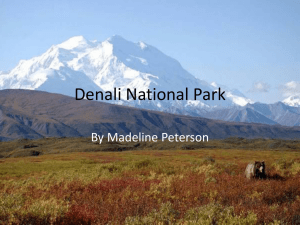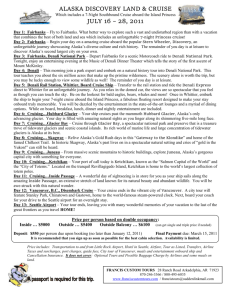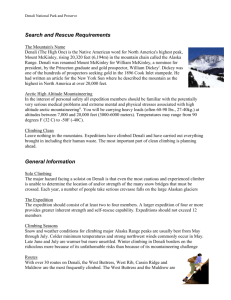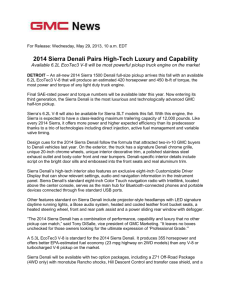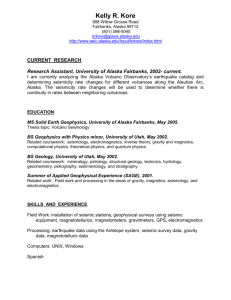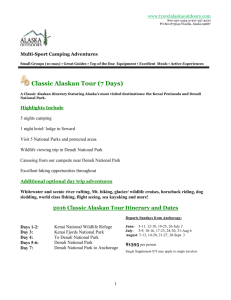Denali National Park - Brown-Leach15
advertisement
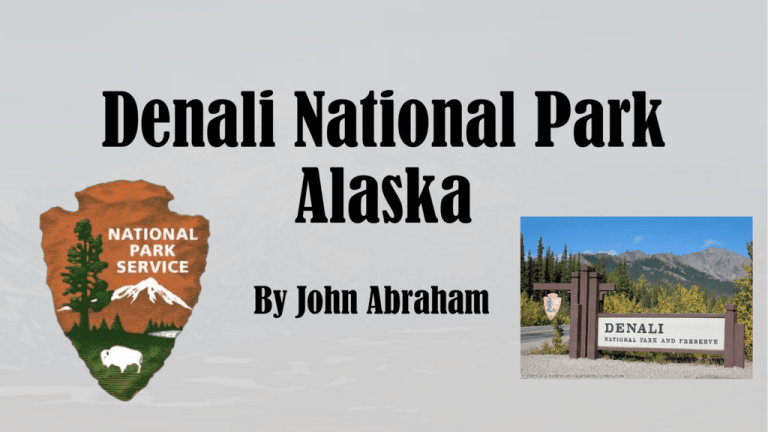
Denali National Park Alaska By John Abraham Where is Denali National Park? Denali National Park is located in South Central Alaska, approximately 120 miles away from Anchorage. It is the 3rd largest National Park in the United States. When was Denali National Park Established? • In 1907-1908, a naturalist named Charles Sheldon came to Denali to study Dall sheep. He saw that mining and big game hunters were also coming to the Denali area. He knew the increase in visitors would not be good for the natural environment and wildlife and wanted to protect the area. • He returned to Washington, DC and proposed that the area become a National Park to protect the wildlife. • He was successful and President Wilson signed a bill into law to make Denali a National Park on February 26, 1917. Charles Sheldon How was Denali National Park Formed? • The oldest rocks in the park date back to the Paleozoic era, about 300-500 million years ago • The park is located on the Denali fault, an active fault where the Pacific Plate is sliding underneath the North American Plate. As this subduction happened during the last 100 million years, the mountain ranges we see today in Southern Alaska were formed. This includes coastal mountain ranges and inland ranges such as the Alaska Range that includes Denali. • Denali formed about 70 million years ago when a huge pool of magma several kilometers beneath the surface cooled very slowly and formed the hard igneous rock, granite. Then, because of it’s location on the fault, it has been pushed up over millions of years. • Denali’s neighboring mountains consist of soft rocks (limestone, shale) that weather easily, compared to the Denali’s granite. This creates a big difference in the heights of Denali and the rest of the Alaska Range. Subduction of Oceanic Crust under Continental Crust Left: Subduction of Pacific Plate Under North American Plate in Alaska. Above: Denali towers over neighboring mountains. Rocks Found in Denali National Park • Denali is one of the few mountains in the world that is made up almost of all one type of rock. In this case, Denali is made of the igneous rock, granite. • Denali’s neighboring mountains in the Alaska Range are made up of sedimentary rocks. These are primarily limestone, sandstone and shale. These rocks are much weaker than granite and therefore erode faster than Denali. This creates the large height difference between Denali and its neighboring mountains. Granite From left to right: sandstone, shale, and limestone What are Special Landforms are Inside Denali National Park? Denali/Mount Mc Kinley • Denali (formerly known as Mount Mc Kinley) is the most well known feature inside Denali National Park. • It is the tallest mountain in North America at 20,237 feet. • Denali means “the Tall One” or “the Great One” in Athabascan. • It is part of the Alaska Range of Mountains. • The lowest point in the park (at the Yenta River Valley is 200 feet above sea level. Bodies of Water • There are approximately 12,200 lakes/ponds and 18,000 miles of streams. • Wonder Lake – The most well known lake in the Park. It was created by debris from glacier advance and retreat • Kettle ponds – Formed when chunks of glacier ice broke off and created a depression that filled with fresh water Denali (Mt. McKinley) Glaciers • There are at least 40 named and hundreds of unnamed glaciers covering approximately 1/6 of the park. • Glaciers are located from elevations as high as 19,000 feet down to 800 feet. • The Kahiltna Glacier is the longest glacier in the park (& the entire Alaska Range) is 44 miles in length. Kahiltna Glacier Flat Lands and Forests • Tundra at high elevations • Forests of spruce, poplar and aspen trees • Glacial erratics – large rocks left behind by ancient glaciers. Left: Glacial Erratic Environmental Issues Facing Denali National Park Human Development – Alters the natural landscape and brings more humans to places they wouldn’t normally have gone Global Warming – Increased global temperatures have caused the glaciers to thin and melt away. Air Quality – Pollution from Asia and Europe makes its way to Denali. Busses travel the paved road bringing thousands of visitors to the park. Exotic Plants – Plants that aren’t native to the park are introduced and are invasive. They climb and spread over native plants. An example is bird vetch, an invasive plant. Sound Quality – Human generated noise disturbs the sounds of nature. Earthquakes – Because of plate tectonics and Denali’s location on the active Denali fault, strong earthquakes are possible in the park. Earthquakes can damage natural features and human developments. Denali continues to grow by approximately 1mm per year. Migratory Birds – Migration patterns are in danger because of human development and activity in the park. Bird Vetch, an invasive plant. Technologies Used in Denali National Park • Seismographs – used to study earthquakes in the park and along the Alaska Range. • Cameras and motion detectors are being used to observe glacial changes and animal activity. • Air quality Monitors – used to study levels of pollution in the park. • Telemetry put collars on wildlife that send radio signals to tell people where it is. • Aerial Surveys They use helicopters and other flying vehicles to take surveys. • Weather stations – located throughout the park and help provide current information for visitors as well as data for studying climate change. • GPS Is used to determine were certain things are. • Internet – Used to inform visitors about the park and share information. Denali visibility webcam http://www.nature.nps.gov/air/webcams/parks/denacam/denacam.cfm Seismograph Weather Station How is the Land inside the park currently changing? Changes due to Plate Tectonics • The forces of plate tectonics that created the park continue to impact the park today. • The Pacific Plate continues to actively subduct under the North American Plate at a rate of 2 inches per year. • These subduction forces result in the mountains continuing to “grow”. The mountains surrounding Denali grow and weather at about the same rate. Since Denali does not weather nearly as much as its neighboring mountains, it actually continues to grow at a rate of 1 mm per year. • Earthquake activity along the Denali fault continues to impact the park’s landscape. • In 2002, the Denali fault experienced a Magnitude 7.9 earthquake. • This resulted in cracks in the ground up to 6.7 m (22 feet wide) and mudslides that move huge volumes of earth. Road Damage from 2002 Earthquake Mudslides can move mountainsides How is the Land inside the park currently changing? (continued) Changes due to Global Warming • Nearly all glaciers surveyed in Alaska are melting due to increased global temperatures. Thinning rates in the last 5 to 7 years are more than twice those seen in previous years. Half of the water flowing into the oceans, globally, due to melting glaciers, is a result of melting in Alaska. • The increased temperatures are causing the park’s permafrost regions (areas frozen for more than 2 years) to thaw. This allows new vegetation to grow, filling in glacial wash areas and shrinking pond/lake areas. Changes due to Human Development • One final area is the impact that man is having on the park. As more people visit the park, additional facilities are constructed which alters the landscape. In addition where these visitors go can destroy the delicate tundra vegetation. Sunset Glacier, Denali National Park. Above photo shows the decrease in glacial ice that has occurred over 70 years. It is important to remember this glacial ice is hundreds of feet thick. Contour Map of Denali National Park A contour map is a map illustrated with contour lines. This topographic map shows mountains, hills, glaciers and important man made features such as airports. Relief Map of Denali National Park A Relief Map is a map that shows topography through different coloring or shading. It can also be three dimensional. This map shows the topography of Denali National Park. Note the Alaska Range, including Denali, shown in white at the bottom of the park. Experience Denali through its Beautiful Landscape, Wildlife and Plantlife Bibliography http://www.nps.gov/articles/aps-v5-i1-c2.html www.ohranger.com/denali/preservation http://www.livescience.com/40595-denali-mount-mckinley.html http://alaska.usgs.gov/science/geology/images/photo_gallery.html https://www.denaliwildlifetour.com/park-history/history-of-denali-park/ http://traveltips.usatoday.com/denali-national-park-physical-features-104632.html http://traveltips.usatoday.com/denali-national-park-formed-13168.html https://en.wikipedia.org/wiki/Denali_National_Park_and_Preserve http://www.beautifulworld.com/north-america/united-states/denali-national-park http://www.nps.gov/dena/learn/nature/glaciers.htm http://thetrekplanner.com/dnp-glacier-erratics/ http://www.swisseduc.ch/glaciers/alaska/kahiltna_glacier/icons/07_khiltna_crevasses_ponds.jpg Bibliography (continued) http://denalinationalparkpink.weebly.com/landform-featuresrocks-andminerals.html http://www.nps.gov/articles/denali.htm https://www.nature.nps.gov/geology/parks/dena/ http://www.nps.gov/dena/learn/photosmultimedia/webcams-depot.htm http://www.nps.gov/articles/aps-v6-i2-c3.htm http://www.nps.gov/articles/aps-v5-i1-c6.htm http://www.nps.gov/subjects/bears/evolvingtechnologies.htm https://en.wikipedia.org/wiki/Seismometer http://www.wunderground.com/wximage/moyerdestroyer/25 http://www.graylinealaska.com/blog/post.cfm/journey-through-denali-withgray-line-alaska Bibliography (continued) http://earthobservatory.nasa.gov/Features/denali/ http://denalirepeatphotos.uaf.edu:8080/index.php/view-photo-pairs/photopair-page?sort=map&sortb=5&id=Mt_Eielson_Thoro_01 http://earthobservatory.nasa.gov/Features/denali/ http://pubs.usgs.gov/fs/2003/fs014-03/ http://www.nps.gov/features/dena/003/landchange/virtual_tour.html http://denalirepeatphotos.uaf.edu:8080/index.php/view-photo-pairs/photopair-page?sort=map&sortb=5&id=Mt_Eielson_Thoro_01 http://www.nps.gov/dena/learn/nature/climate-change.htm http://www.onesixtyk.com/denali-national-park/5503/ http://www.nationalgeographicexpeditions.com/expeditions/alaskawilderness-family-tour/detail http://www.mapsofworld.com/usa/national-parks/
